In the evolving landscape of construction, where precision and efficiency define success, structural engineers are now faced with the opportunity to redefine their approach through data-driven design. This shift goes beyond traditional methods, integrating real-time data, digital modelling, and advanced computational tools to enhance the design, analysis, and execution of complex structures. Data-driven design allows engineers to work with a dynamic flow of information—whether it’s load data from advanced sensors, material performance metrics, or environmental impact forecasts—which can be integrated into structural and MEP models.
In this blog, we’ll explore why structural engineers need to embrace data-driven design, incorporating real-world applications and discussing how it is transforming the industry. As the construction industry embraces digital transformation, structural engineers who integrate data-driven design into their workflows will not only enhance the reliability of their designs but also contribute to a more efficient and sustainable built environment.
Automating Repetitive Tasks
One of the greatest benefits of data-driven design is the automation of repetitive tasks. Structural engineers spend a considerable amount of time performing manual calculations, adjusting designs, and running analyses. These tasks, while crucial, can be labour-intensive. Data-driven design tools now allow for automation of these processes, reducing the time needed for manual calculations and freeing engineers to focus on more complex and high-value aspects of the construction project.
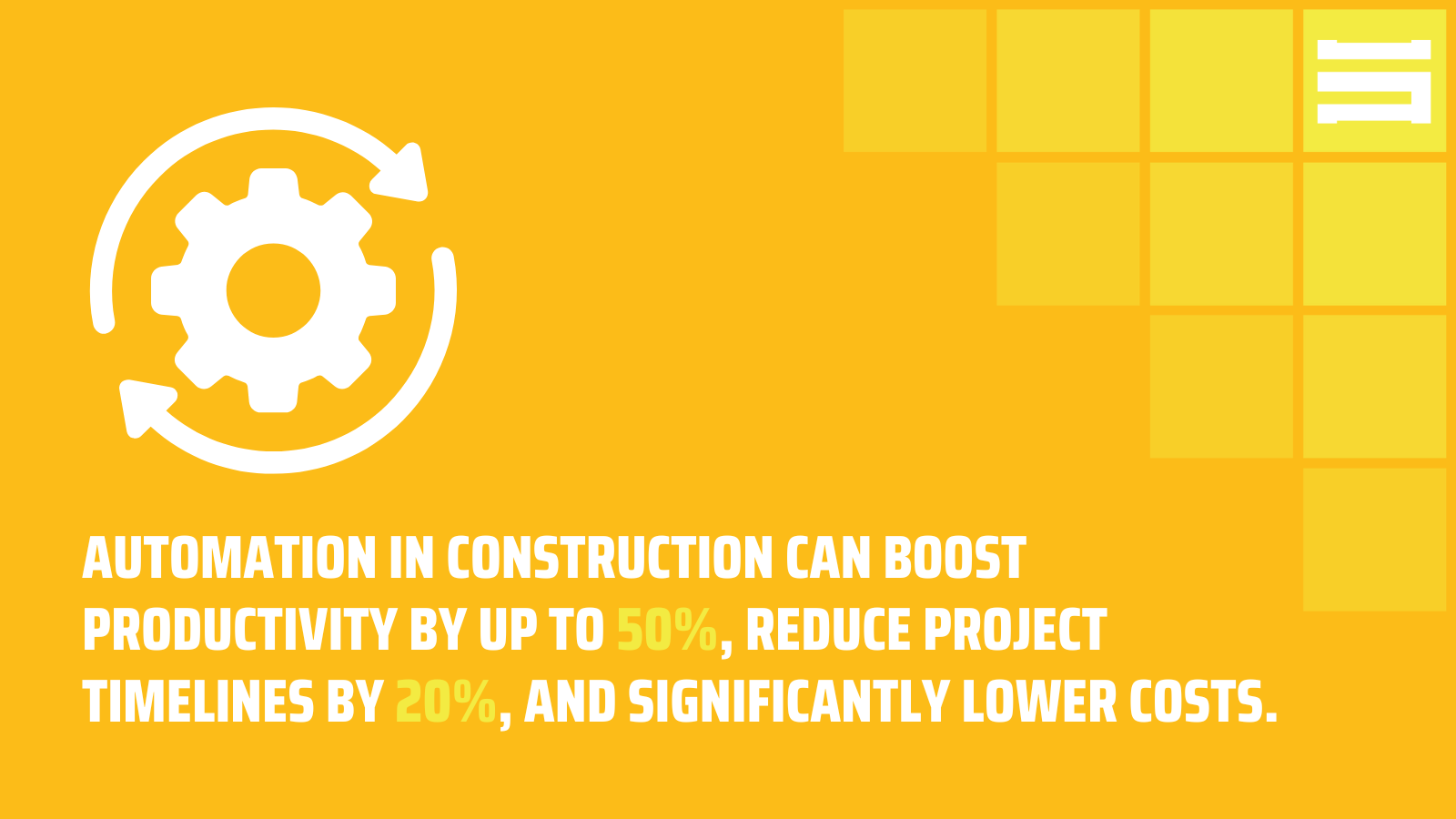
The adoption of automation in construction is primarily driven by its clear and measurable advantages. Studies show that automation can boost productivity by up to 50% and reduce project timelines by 20%. Additionally, automation contributes to cost savings by minimising rework, optimising resource allocation, and improving overall project efficiency. These improvements not only enhance the speed and quality of project delivery but also enable construction teams to better manage resources, reduce errors, and deliver projects within budget.
Real-Life Application
In the construction of stadiums or large commercial buildings, where calculations around load distribution and material performance need constant revising, automation tools can handle the heavy lifting. By inputting essential building parameters, engineers receive instant feedback, allowing them to quickly adjust designs for load paths, stress points, or material choices, significantly speeding up the process while ensuring accuracy.
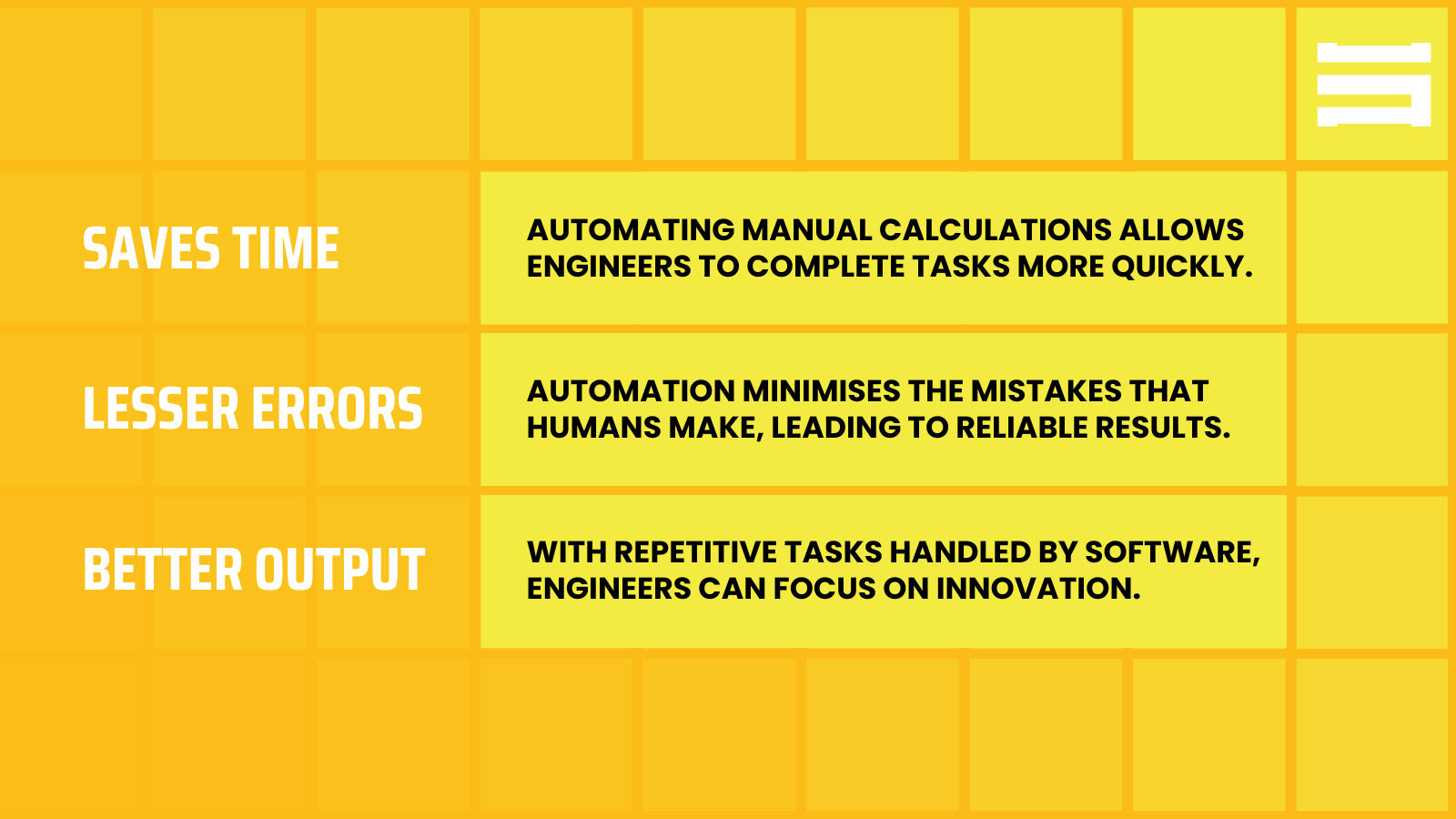
Managing Design Changes Efficiently
Changes during the design phase are inevitable in any construction project. Whether driven by the client, unforeseen site conditions, or evolving regulations, design alterations can disrupt timelines and increase costs that are monitored by cost management teams. Data-driven design tools, however, allow structural engineers to manage changes efficiently without slowing down the project.
Real-Life Application
In infrastructure projects, data-driven tools allow engineers to modify design elements, such as room layouts or structural load configurations, on the fly. These changes are automatically reflected throughout the 3D model, ensuring that adjustments are seamlessly integrated into the overall design. For example, if a client requests changes to the building’s floor plan, the design tool can instantly update load-bearing elements and structural supports without requiring a complete redesign.
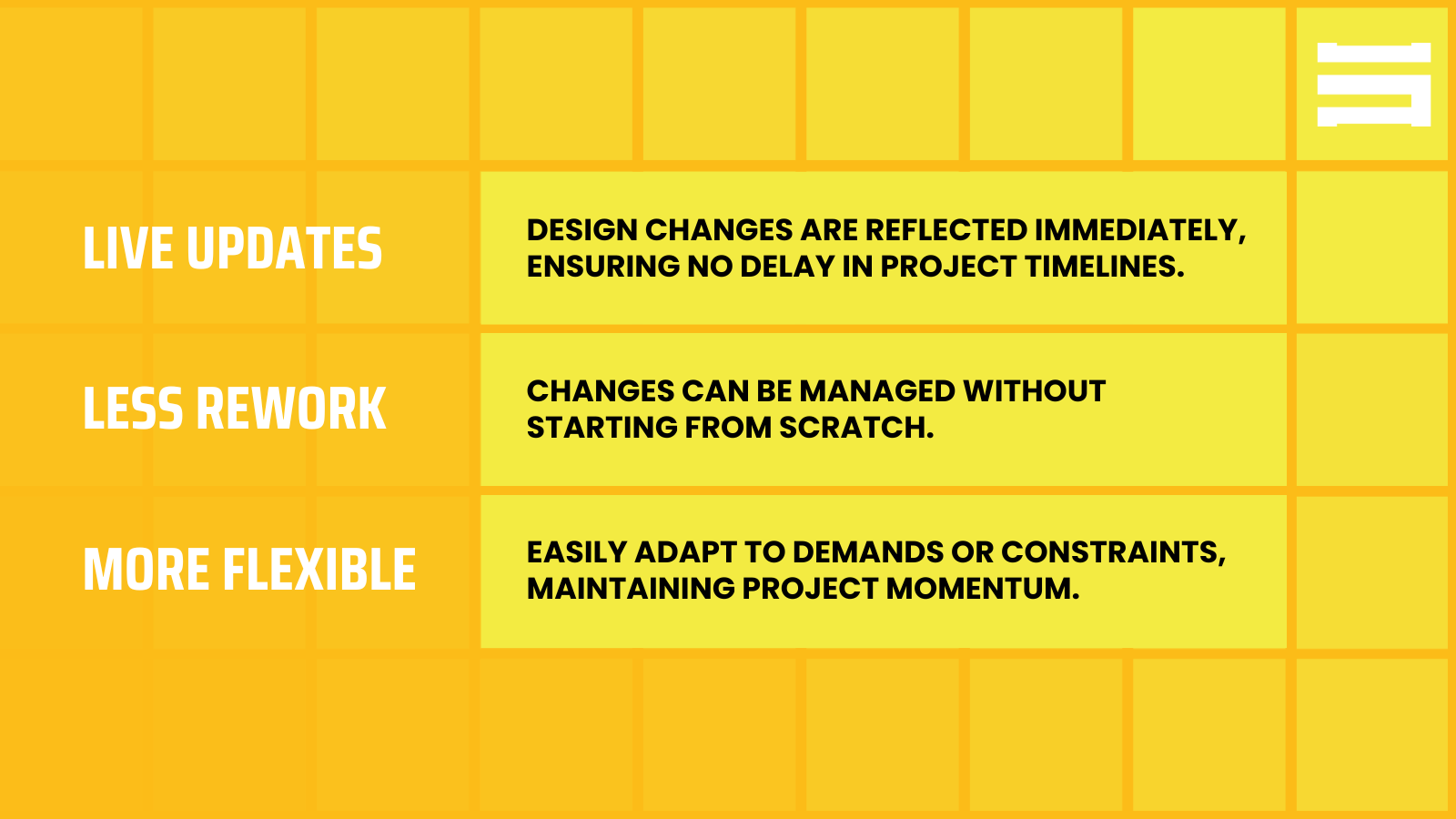
Increasing Accuracy and Reducing Risk
Accuracy is crucial in structural engineering—small miscalculations can have significant consequences. Data-driven design tools enable engineers to run real-time simulations that test the performance of their designs under different conditions, such as wind loads, earthquakes, or extreme temperatures. This helps identify potential weaknesses before construction begins, significantly reducing risk.
Real-Life Application
In projects such as high-rise buildings, real-time simulations are vital to assess how a structure will behave under different conditions. For example, in areas prone to seismic activity, engineers can use data-driven simulations to model how a building will respond to earthquakes of varying intensities. By making necessary design adjustments during the planning phase, they can mitigate risk and ensure compliance with safety regulations, long before the first brick is laid.
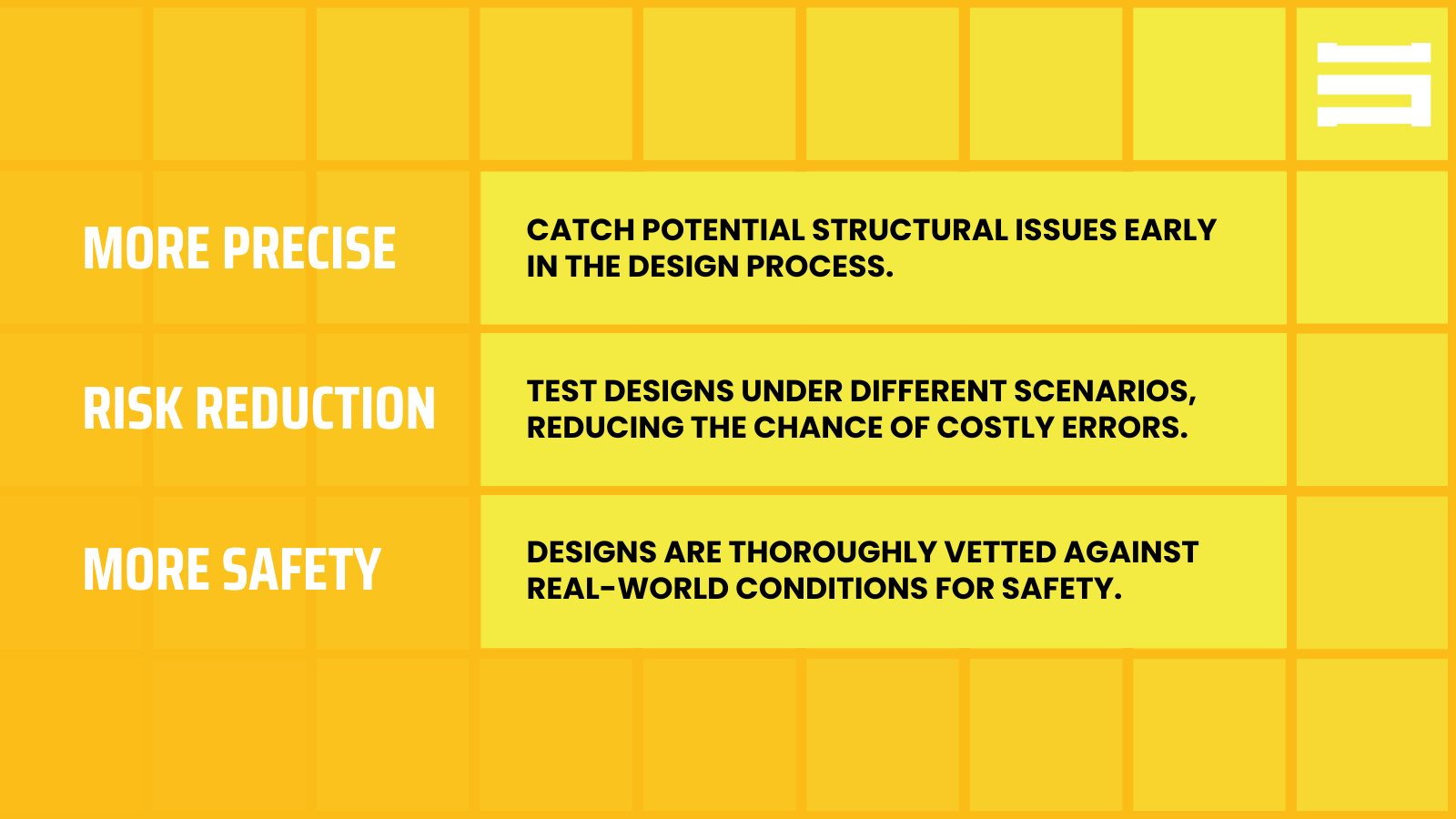
Optimising Cost-Effectiveness
Budget constraints are common in construction, and keeping costs under control is a priority for cost consultants, clients and engineers. Data-driven design tools help structural engineers optimise costs by providing more accurate project estimates and reducing the need for rework. By running different simulations and assessing various design options, engineers can find cost-effective solutions that don’t compromise on performance or safety.
Real-Life Application
In the design of commercial buildings, such as offices or shopping malls, engineers can use data-driven design to explore different material choices and construction techniques. For instance, by simulating the impact of using steel versus reinforced concrete, engineers can make informed decisions about which material will deliver the most cost-effective solution while maintaining structural integrity. This not only reduces material waste but also leads to more predictable and manageable budgets.
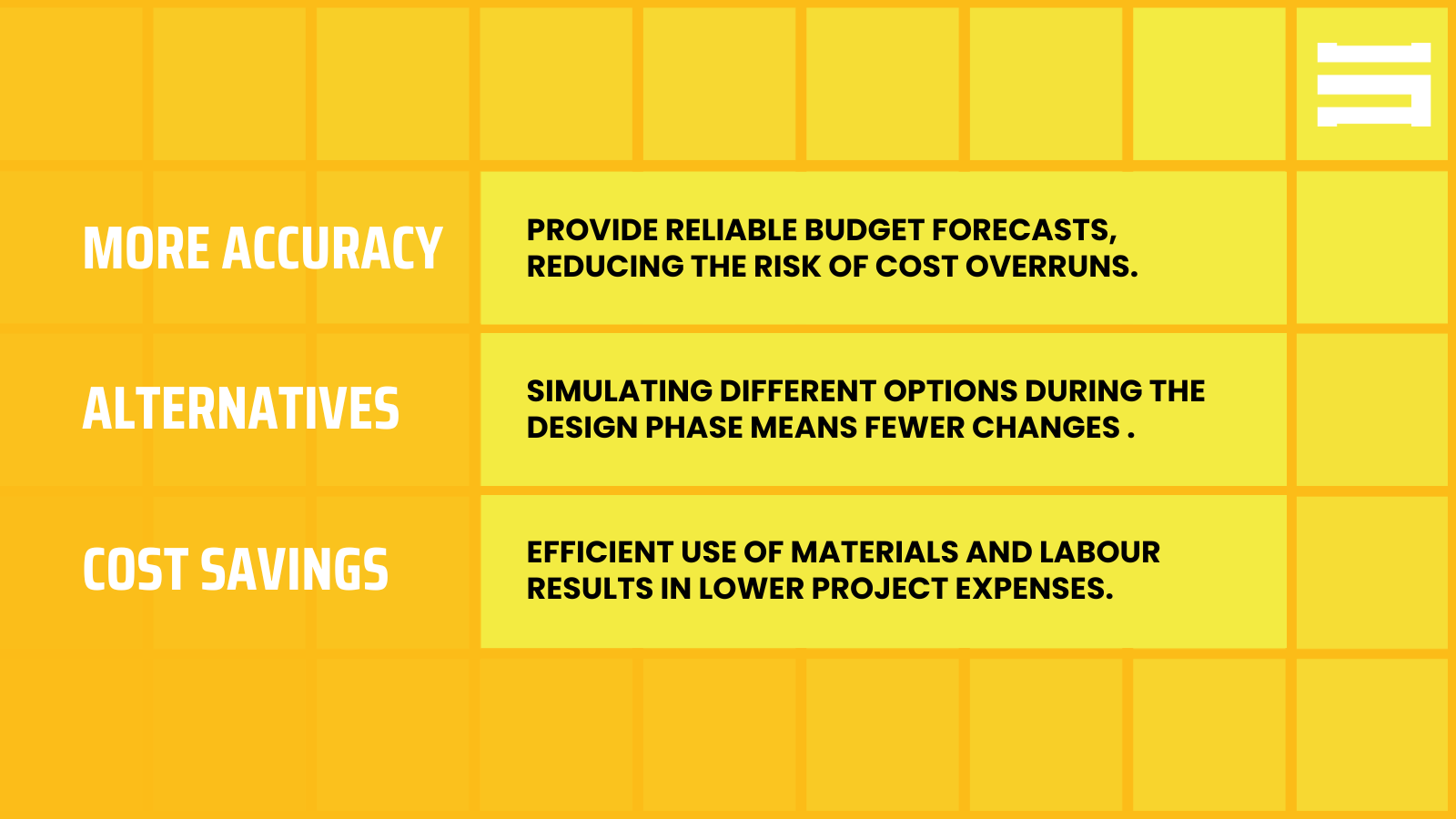
What are the Approaches Taken in Data-Driven Structural Engineering?
The adoption of data-driven design in structural engineering is built on several key approaches:
- Building Information Modelling (BIM): BIM is one of the most powerful tools for integrating various design elements into a shared platform, enabling collaboration between all project stakeholders. Engineers, architects, and contractors can work from the same model, ensuring seamless integration of different project aspects.
- Artificial Intelligence and Machine Learning: AI and machine learning technologies are increasingly being used to automate tasks, predict potential issues, and optimise structural designs. By learning from past projects, these tools can improve the accuracy and efficiency of new designs.
- Cloud-Based Collaboration: Cloud platforms allow teams to collaborate from anywhere, ensuring that data is accessible to all relevant stakeholders in real-time, regardless of their location.
What are the Challenges in Adopting Data-Driven Design?
While data-driven design offers undeniable benefits, it’s not without its challenges. The transition can be complex and requires significant investment—both in terms of money and time. Whether you are part of a large engineering firm or a smaller consultancy, the hurdles can feel daunting. But as with any innovation, understanding these challenges is the first step in overcoming them. Let’s break down the main barriers.
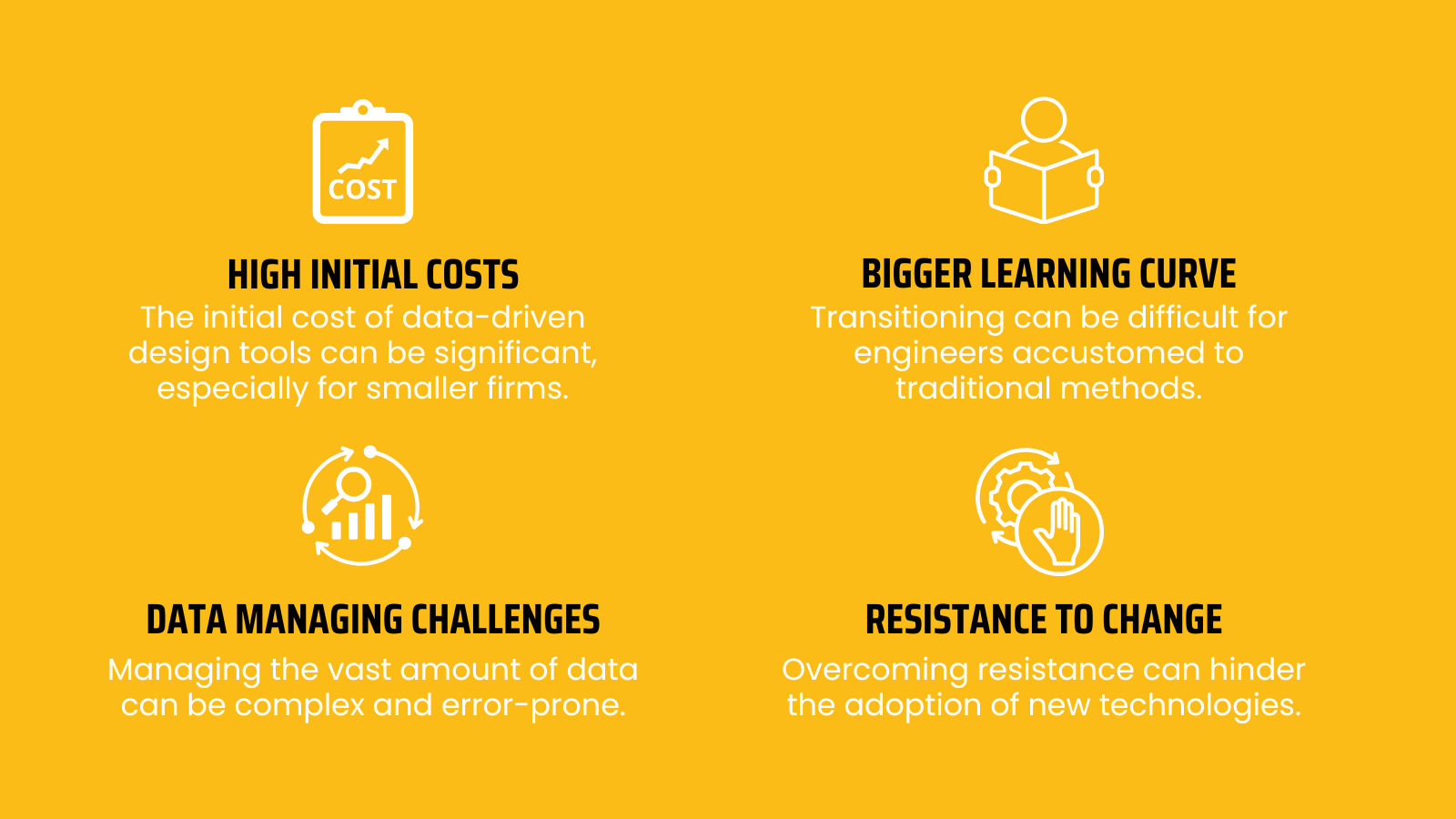
1. High Initial Costs
Let’s be real: adopting data-driven design tools comes with a price tag. The upfront costs of purchasing advanced software, upgrading hardware, and setting up the necessary infrastructure can be substantial. For smaller firms, this can feel like a big leap, especially if you're already operating on tight margins. The investment doesn’t stop there—there’s also the cost of training your team to use these tools effectively.
While larger firms may have the resources to absorb these costs, smaller firms often must be more strategic. It’s not just about buying the latest software; it’s about making sure your investment delivers a strong return in the long run.
How to Tackle It:
You don’t need to invest in everything all at once. Start with the most critical tools that will bring the most immediate value to your projects. For example, focus on tools that help with automating tasks or improving design accuracy. Many software providers offer subscription models, which can help spread out the cost over time. Additionally, seeking out grants, government funding, or partnerships with educational institutions could also alleviate the financial burden.
2. Learning Curve
Even with the right tools, making the switch to data-driven workflows can be overwhelming, especially for engineers who have been doing things a certain way for years. Let’s face it, change is hard. Adopting new technologies requires not only learning the software itself but also understanding how to interpret the data and use it to improve your designs.
For many firms, this is one of the biggest challenges. You’re not just teaching your team how to use new software—you’re changing the way they think about design, workflows, and problem-solving.
How to Tackle It:
Start small. Introduce data-driven tools incrementally. Use them on simpler projects first to allow your team to get comfortable before applying them to larger, more complex designs. Make sure your team gets adequate training, but more importantly, foster a culture of continuous learning. Pair senior engineers with those more familiar with digital tools to facilitate knowledge sharing. The key here is patience—change doesn’t happen overnight, and small wins will build momentum.
3. Data Management
Data is the heart of data-driven design—obviously. But managing all that data? That’s a challenge. From project specs and material properties to real-time updates and compliance information, the sheer volume of data can be overwhelming. Poor data management can lead to costly mistakes, like using outdated design versions or miscommunication between teams.
You’ve got to ensure that all your data is properly stored, easily accessible, and—most importantly—secure. If you don’t have a proper system in place, you run the risk of errors that can delay your project or inflate your budget.
How to Tackle It:
Invest in cloud-based platforms that allow for easy access and real-time collaboration. These platforms ensure that all stakeholders—whether they’re architects, contractors, or engineers—are always working from the most current data. Make sure your firm has clear data management protocols in place. Who updates the data? When is it updated? Who’s responsible for overseeing its accuracy? Having a dedicated team or individual in charge of data management can reduce the chances of errors and keep your projects running smoothly.
4. Resistance to Change
Even the best tools won’t matter if your team—or your clients—aren’t on board. Resistance to change is one of the most common challenges when introducing new technologies. It’s human nature to stick with what we know. Some engineers may be reluctant to give up traditional methods that they’ve relied on for years. On the client side, there may be pushback if they don’t fully understand the value of these new tools or if they perceive them as adding unnecessary complexity.
This resistance can slow down the implementation process, creating friction and delaying project timelines.
How to Tackle It:
Communication is key. Clearly explain the benefits of data-driven design—faster timelines, fewer errors, and more accurate cost estimates. Show real-world case studies where this technology has delivered measurable results. Engage your team and clients early in the process, offering demonstrations or pilot projects to help them get comfortable with the tools before fully committing. Small successes will help build trust and ease the transition. Remember, change management isn’t just about tools—it’s about people.
Future of Data-Driven Design in Structural Engineering
The future of structural engineering will continue to be shaped by data-driven design. As technology evolves, new tools such as AI, machine learning, and real-time simulation will become more advanced, offering even greater opportunities for innovation and efficiency. Structural engineers who embrace these changes now will be better equipped to lead the industry in the future, delivering safer, more sustainable, and cost-effective projects.
In regions like the UAE, where urban development is expanding rapidly, data-driven design will play a key role in meeting the demands for smart cities and sustainable infrastructure. Structural consultants in the UAE are increasingly adopting these methodologies to meet the growing needs of modern urban environments.
Conclusion
Data-driven design is transforming the structural engineering industry, offering significant benefits in terms of efficiency, accuracy, cost savings, and collaboration. By automating repetitive tasks, managing design changes seamlessly, enhancing collaboration, and reducing risks, structural engineers can deliver projects faster, more accurately, and with fewer costs.
For structural consultants and firms offering structural engineering services, adopting data-driven methodologies isn’t just a trend—it’s a necessity for staying competitive in a rapidly evolving industry.
About us
Stonehaven is a trusted project management company and construction consultant based in Dubai, offering comprehensive construction management services across the UAE with offices located in Dubai, UK and Sri Lanka. As one of the leading project management companies in Dubai, we manage projects from inception to completion, ensuring quality, efficiency, and cost-effectiveness at every stage.
We deliver value through expert project management consultancy services, tailored to meet the unique needs of each client. Our core services include Cost Management, Project Management, Construction Supervision, Engineering Support, Design Support, and Marketing & Communications. Whether you’re looking for construction consultants or project managers in the UAE and wider GCC region, Stonehaven is your trusted partner for achieving excellence in your next project.
At Stonehaven, we specialise in providing advanced structural engineering services. Whether you're searching for structural consultants in the UAE or looking for structural engineering services near me, we use cutting-edge, data-driven design tools to deliver innovative, cost-effective solutions.
Contact us today to see how Stonehaven can support your next project with our expert structural engineering support services.








